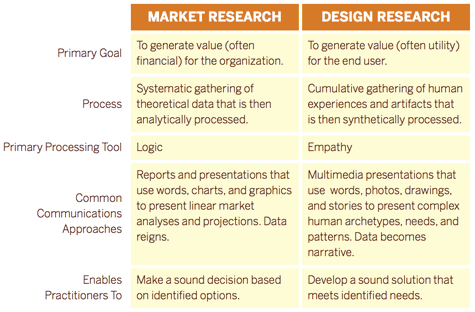What is Design Research?
There are various different types of research that go into a new product or service development, and many which are very closely aligned.
The three key methods you may have come across are market research, user research and design research. For the same reason that we ironed out the differentiating factors between users and customers here, we believe that understanding the differences and overlaps between these areas of research are really important.
With that in mind, we’ll be focussing this week on design research - and how it differs from market research - and next week on user research.
What is design research?
Design research is that which aims to better understand the end users of a product or service, with a view to ensuring the product or service at hand meets their needs and ultimately provides solutions to their problem.
The aim is to use the insights gathered from this research to inform the design process, ensuring that a user-centric approach is taken. Taking this approach reduces the risk of designing innovations which are neither needed nor desired by its target audience.
In addition to learning about the user, design research is also interested in understanding project requirements from the perspective of its stakeholders, or from the wider business; “design research is focused on learning about project requirements from stakeholders, and learning about the needs and goals of the end users.” (Source).
It’s because of this that we believe design research actually encapsulates both user and market research; it’s concerned not only with the user, but also with the market, looking at elements such as wider industry activity and competition. We particularly like this quote in summarising its wider role: “[design research is] research specifically undertaken to support the strategic design and development of products, services, and programs.” (Source). It is the ‘strategic’ element that we believe so closely aligns design research with market research.
Why should we use it?
Designing and developing a product or service without evidence that your target market needs or wants it can lead to wasted time and money. Bad design is expensive. By listening to and empathising with our users, we are encouraged to look at the design from their perspective, and understand how they would incorporate it into their world. We need to treat our users as experts in the design process, and try to rid our mind of any preconceived notions.
“The main goal of design research is to inform the design process from the perspective of the end user. It is research that prevents us from designing for one user: ourselves.” (Source)
A really important aspect of design research is to remember that we are not designing for ourselves. Often easier said than done, it is vital to completely free our mind of our own predispositions and our own view of the world, and instead to fully immerse ourselves into the world of our user. Even if it is the polar opposite of ours.
Taking this approach and conducting this research reduces the risk of designing a product or service that isn’t well received by our users; identifying the relevant product-solution fit can lead to great success for innovative solutions.
Design research vs market research
As mentioned, we believe that design and market research are very closely aligned, to the extent that some of their principles overlap.
However, it is generally understood that one of the key differentiators between design research and market research, as demonstrated by the table below, is the mindset with which it is carried out, and the overarching goal of the research. Where market research typically sets out to gather and assess quantitative data - and often with a view to understanding the financial viability of a product or service - design research looks to build empathy with the target market and to learn about their experiences.
So while design research does take into account the business requirements and strategy behind product and service design, the overarching aims of each method differ in practice.
The takeaways
The relationship between the key types of research in product and service design are very closely intertwined; whilst they generally have unique aims and goals, they can often be seen to overlap.
We hope this post provides some clarity as to the nature and purpose of design research, as well its similarities and differences with market research. Next week we’ll be honing in on user research, identifying how that aligns with design research, as well as looking at next steps and how we make sense of the data we gather through this research process.

